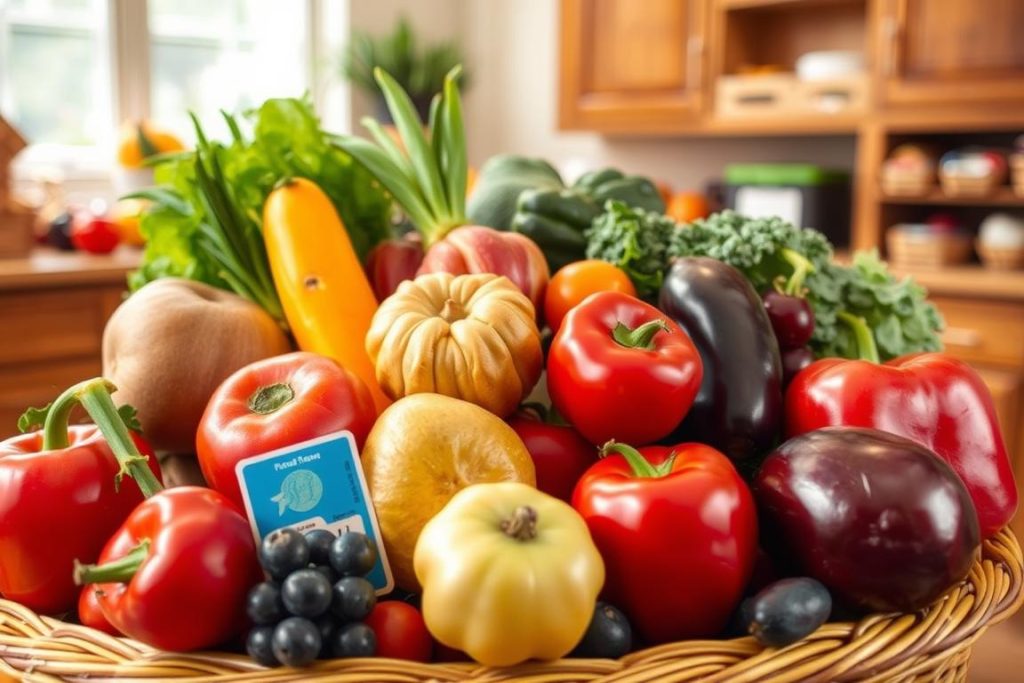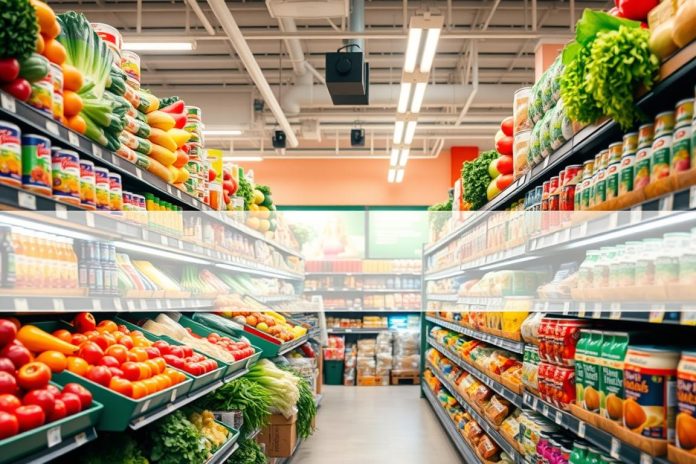Did you know California has the highest poverty rate in the U.S. due to living costs? About 15.7% of families with kids don’t have enough food1. This makes it crucial to help your food budget. Programs like CalFresh are key for families with low income.
CalFresh helps over 30,000 households every month through GetCalFresh.org1. This program gives benefits via EBT cards, to buy healthy foods1. Eating well is easier this way. SNAP has also lowered the poverty rate significantly, showing its wide impact1.
It’s tough for low-income families to manage food costs. Yet, programs like CalFresh don’t just offer short-term help. They improve your food quality and boost the economy in your area.
Key Takeaways
- California tops U.S. poverty rates when factoring in living expenses1.
- CalFresh helps over 30,000 households get food assistance each month1.
- Food programs like CalFresh are crucial for families with low income, boosting local economies too1.
- EBT cards let people buy nutritious food at many places.
- Every $5 from SNAP creates $9 in economic activity1.
Understanding Different Government Food Assistance Programs
Government and private groups offer help with food to those who need it. Programs like SNAP, WIC, and TEFAP make sure millions of Americans get good food every year. They help low-income families, kids, and older adults get the nutritious meals they need.
Supplemental Nutrition Assistance Program (SNAP)
The Supplemental Nutrition Assistance Program, or SNAP, is here to help people buy healthy food. To get SNAP benefits, you need to meet certain income and resource rules2. The number of people using SNAP jumped to 27.5 million by 1994 from just over 500,000 in 19653. In 2014, the USDA put $31.5 million into helping SNAP users buy more fruits and veggies3.

Women, Infants, and Children (WIC) Program
The WIC Program does more than just give out food. It provides nutrition advice and links to social services for moms and young children. Since 1974, PA WIC has worked to make Pennsylvania families healthier, focusing on pregnant women and those caring for little ones4. WIC is super important for young children’s growth, offering food packages that support their development.
Emergency Food Assistance Program (TEFAP)
TEFAP is key in supporting the nation’s nutritional safety by giving free emergency food to low-income individuals. This program helps those in need, working alongside federal efforts4. Groups like 412 Food Rescue help a lot by giving out unused food to those without enough4. Their work is crucial in ensuring everyone can get healthy food.
Getting to know these programs helps you make sure your family eats well, especially in hard times. Both federal and local efforts aim to make sure everybody has access to good food.
Food assistance programs: How to Apply and What to Expect
To apply for food help, start by understanding the application process and who qualifies. Find the best program for you or your family. Then, fill out and turn in the needed paperwork to the right agency.
The process of getting food benefits involves a few key steps. These include checking your household’s income, how many people live there, and their nutritional needs. For example, the SNAP program updates its income and resource limits yearly, reflecting cost of living changes5. Once you apply, most agencies will make a decision within 30 days. However, in some cases, benefits might arrive in just 7 days6.
Let’s look at SNAP to understand how to join a nutrition program. In 2023, over 42 million people used SNAP for family support. This is about one in every eight Americans6. To qualify, families must meet income limits. These limits are based on the whole income and the income after certain deductions. Also, families can’t have too many resources, like savings. For example, up to $2,750, or $4,250 for households with elderly or disabled members5. Even cars might affect your eligibility.
After you apply, what happens next can differ across food aid programs. For instance, SNAP gives families an EBT card. It works like a debit card for buying food at certain stores6. Families need to check their income regularly to keep getting help. SNAP allows buying many types of food, including seeds for growing your own food6.
Other programs like WIC let families change allowed foods easily and join without visiting in person. The USDA quickly approves changes for WIC under the Families First Coronavirus Response Act7. TEFAP offers extra emergency food, and food banks have created safe ways to give out food, like drive-through pickups, during the pandemic7.
Conclusion
Government food help like SNAP, WIC, and TEFAP is key to better food security for many Americans. They help lower the cost of food bills, making sure people have access to good nutrition. Getting these benefits is a big step towards better financial health and well-being.
The amount of SNAP benefits a household gets is influenced by things like how much time they have to prepare meals and food prices. This can be measured with the evidence we have8. The latest numbers from the USDA show that hunger is still a problem after the recession. This tells us that food help programs need continuous improvement9.
Details like the most SNAP benefits you can get and how they figure out your income matter a lot8. To make these programs better, suggestions include more job chances for SNAP users and adjusting benefits as earned income changes. This helps reduce reliance on food help and fights hunger more effectively9.
Knowing about and applying for food aid helps the effort to feed communities and improve nutrition nationwide. Use these chances to make your diet better and ease money worries. This helps build a healthier future for you and your family.
FAQ
What is CalFresh and how does it help with grocery bills?
How do I know if I am eligible for CalFresh?
What types of food assistance programs are available beside CalFresh?
What is the WIC Program and who can benefit from it?
How does the Emergency Food Assistance Program (TEFAP) work?
What should I expect during the food assistance application process?
Can I use EBT cards at places other than grocery stores?
Where can I find more information about community food programs?
Source Links
- Why Californians need food assistance – https://codeforamerica.org/explore/snapstories/
- Food Assistance and Food System Resources – https://www.cdc.gov/nutrition/php/resources/food-and-food-system-resources.html
- SNAP, Explained | Move For Hunger – https://moveforhunger.org/snap-explained
- Food Programs | Department of Human Services – https://www.pa.gov/en/agencies/dhs/resources/ending-hunger/food-programs.html
- SNAP Eligibility | Food and Nutrition Service – https://www.fns.usda.gov/snap/recipient/eligibility
- What Is SNAP: How To Apply for Benefits & How Much To Expect – https://www.incharge.org/debt-relief/snap-food-stamps-how-to-qualify-apply-and-how-much-benefit/
- Food Assistance – https://www.usda.gov/coronavirus/food-assistance
- Conclusions and Recommendations – Supplemental Nutrition Assistance Program – https://www.ncbi.nlm.nih.gov/books/NBK206905/
- Recommendations and Conclusion – Center for Hunger Free Communities – https://drexel.edu/hunger-free-center/research/briefs-and-reports/hunger-commission/recommendations/

